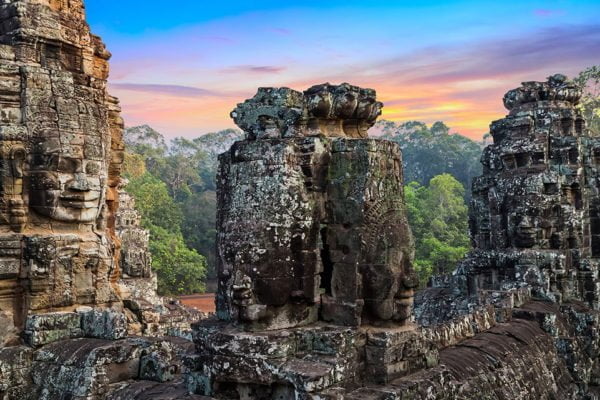15 Essential Cambodian Etiquette Rules for First-Time Visitors
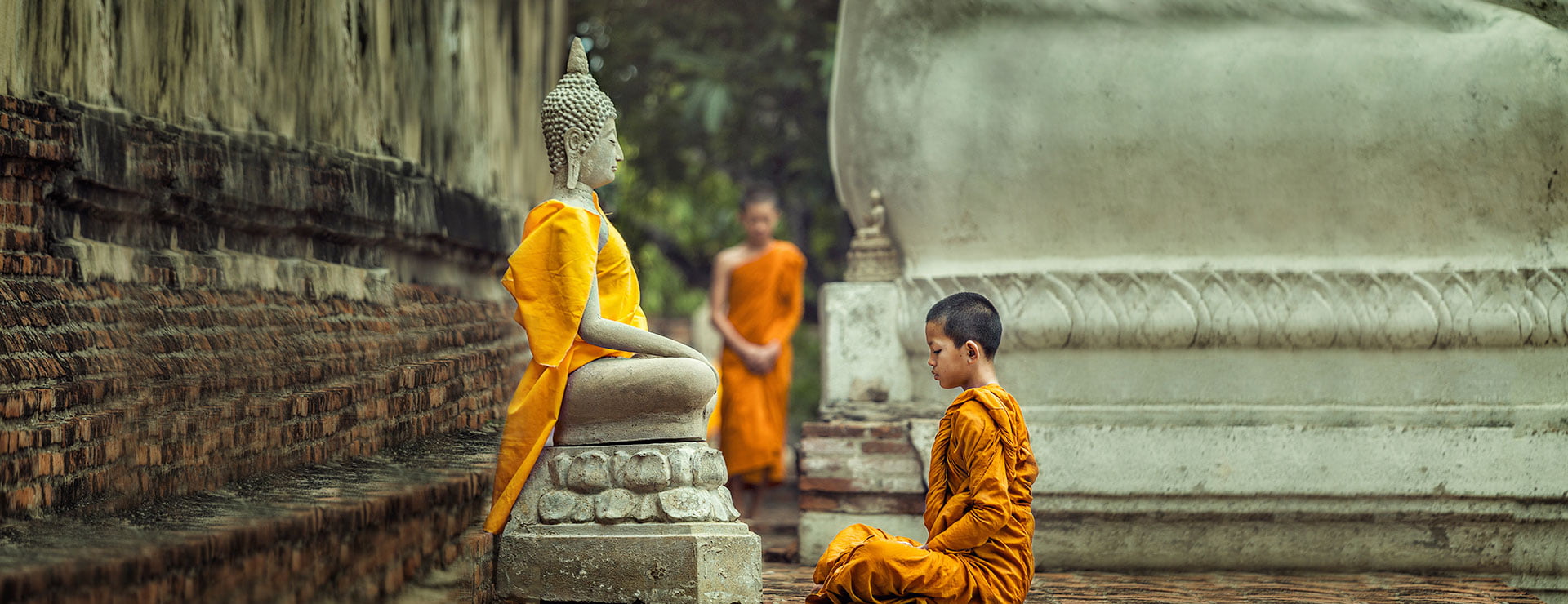
Cambodia, a Southeast Asian nation with deep Buddhist traditions, requires visitors to follow specific cultural protocols to show proper respect. Understanding these Cambodia etiquette rules is crucial for meaningful travel experiences and avoiding cultural missteps. Scroll down for the full guide!
Why Understanding Cambodian Etiquette Matters
- Small gestures open doors to genuine local connection
Travelers often arrive in Cambodia eager to see its golden temples, floating villages, and rice fields shimmering under the sun. Yet the true heart of the journey often lies in the subtler moments. A gentle bow with palms pressed together—the sampeah, Cambodia etiquette for graceful greeting—carries more weight than words can express.
It is a sign of humility, respect, and shared humanity. When you return a smile with this simple gesture, the atmosphere shifts. What could have been a passing encounter turns into a spark of warmth, a brief but genuine exchange that lingers longer than the memory of a photograph.
- Cultural awareness earns warm hospitality and deeper travel stories
In Cambodia, kindness is often met with kindness tenfold. Locals remember travelers who show genuine interest in their customs, and those moments often blossom into unexpected stories. A shopkeeper might pause to share a family tradition, or a monk might explain the symbolism behind a ritual you’ve only seen from afar.
Respect becomes the bridge between your curiosity and their willingness to share. Suddenly, the journey is no longer just about seeing Angkor Wat or walking Phnom Penh’s boulevards—it becomes about the people who live within those landscapes, whose hospitality turns your trip into something deeply personal.
- Etiquette helps navigate gracefully and avoid unintentional offense
Every culture has unspoken rules that give daily life its rhythm. In this country, where temples double as community centers and village paths are lined with offerings, awareness of Cambodia etiquette becomes its own form of respect. A thoughtless gesture—like pointing your feet toward a sacred statue—can disrupt harmony without you ever intending it.
However, when you move with mindfulness, observing how locals behave, you carry yourself with quiet grace. Misunderstandings give way to understanding, tense moments soften into calm. And in return, the spaces you enter—whether a bustling market or a tranquil pagoda—remain whole, dignified, and welcoming.
Cambodian Etiquette Essentials: 15 Do’s & Don’ts by Situation
Meeting & Greeting
Master the Sampeah Gesture
The sampeah is much more than a polite hello—it is a gesture that carries centuries of tradition, quietly expressing respect, goodwill, and an understanding of where one stands in the social fabric.
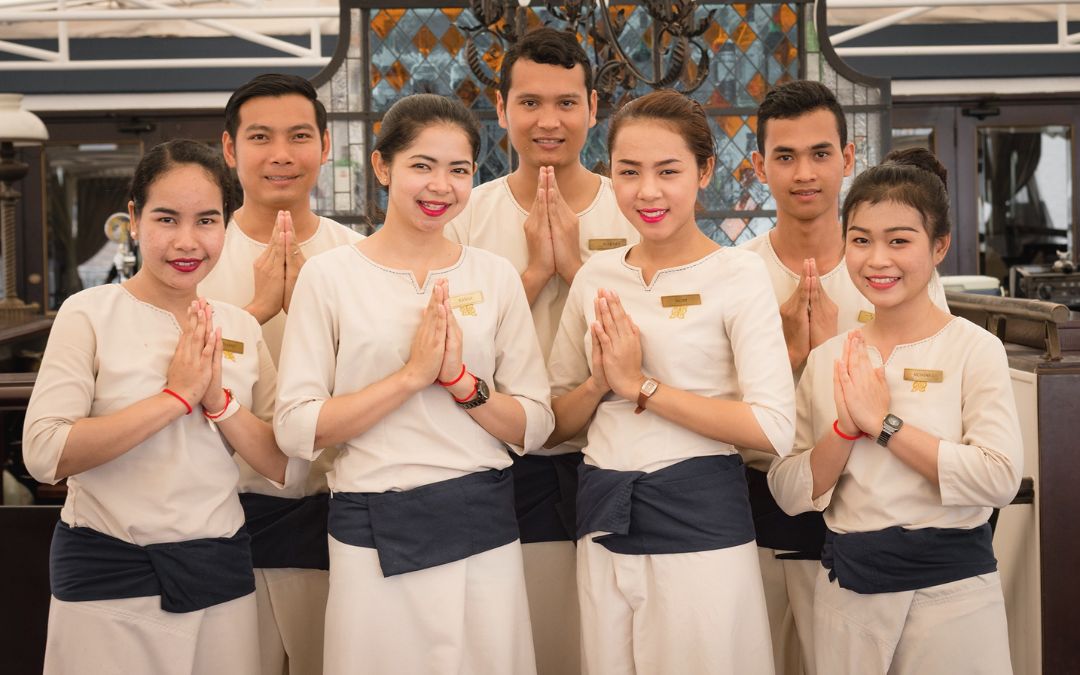
Cambodia etiquette deeply values the Sampeah as a fundamental expression of respect.
To perform it, place your palms together as if in prayer, raise them toward your chest or face, and bow gently. What matters most is not precision but intention. Each level of the sampeah reflects the bond between two people, from equal friendships to deep reverence.
- To peers or those younger: Keep your palms at chest height and bow lightly. This simple form signals warmth, friendliness, and equality.
- To elders, teachers, or supervisors: Lift your hands closer to the mouth or nose and bow a little deeper, showing appreciation for their guidance and seniority.
- To monks or highly respected figures: Raise your hands near your forehead and bow with care. The deeper the gesture, the greater the deference—an act of humility woven into everyday life.
- As a foreign guest: Perfection isn’t expected. Cambodians value sincerity over technique, and even a slightly clumsy sampeah speaks volumes about your willingness to honor their ways.
Use Proper Address
In Cambodia, words carry as much weight as gestures. The way you address someone reveals not just courtesy but also an awareness of hierarchy and cultural rhythm.
- Lok is the respectful prefix used before the name of a man.
- Lok Srey is used before the name of a woman, regardless of marital status.
These titles are most important in first meetings, professional settings, and in conversations with elders. Jumping straight to first names may feel too casual—sometimes even dismissive—unless the relationship has become more familiar. In formal introductions, it is best to wait until your Cambodian counterpart offers how they’d like to be addressed before you shift away from honorifics. Small details like this show patience, humility, and openness.
Avoid Overly Casual Touch
In Cambodia, physical contact speaks its own language. While handshakes are common in business circles, especially in Phnom Penh or Siem Reap, they are not the default in daily life. If unsure, let the local set the tone—and when in doubt, fall back on the timeless grace of the sampeah.
Back or shoulder pats, often considered friendly in Western contexts, can come across as too informal here. The head, believed to be the most sacred part of the body, should never be touched—not even playfully with children. Gender dynamics matter, too; public contact between men and women is generally avoided. A thoughtful pause before reaching out ensures that your gesture is received as respect, not intrusion.
Where to Practice Meetings and Greetings
Opportunities to share the sampeah are woven into daily encounters across Cambodia, each one offering a chance to connect more deeply.
- Village visits: In rural communities, elders carry profound respect. A higher sampeah paired with proper Cambodia etiquette opens doors quickly, often shifting your role from passing visitor to welcomed guest.
- Markets: Among colorful stalls and the fragrance of fresh herbs, a vendor’s brief sampeah may be your first greeting. Returning it, even casually, often leads to warmer exchanges, friendlier prices, and demonstrates better Cambodia etiquette.
- Guesthouse check-ins: Many family-run guesthouses begin interactions with a sampeah. Echoing the gesture and addressing the staff with “Lok” or “Lok Srey” instantly sets a tone of mutual respect, creating a stay that feels more like visiting a friend’s home than checking into a room.
- Festivals and ceremonies: During sacred celebrations, greetings carry heightened meaning. Watch how others perform the sampeah, then follow their lead. The shared rhythm of bows and smiles draws you into the spirit of the gathering, allowing you to feel less like an observer and more like a participant.
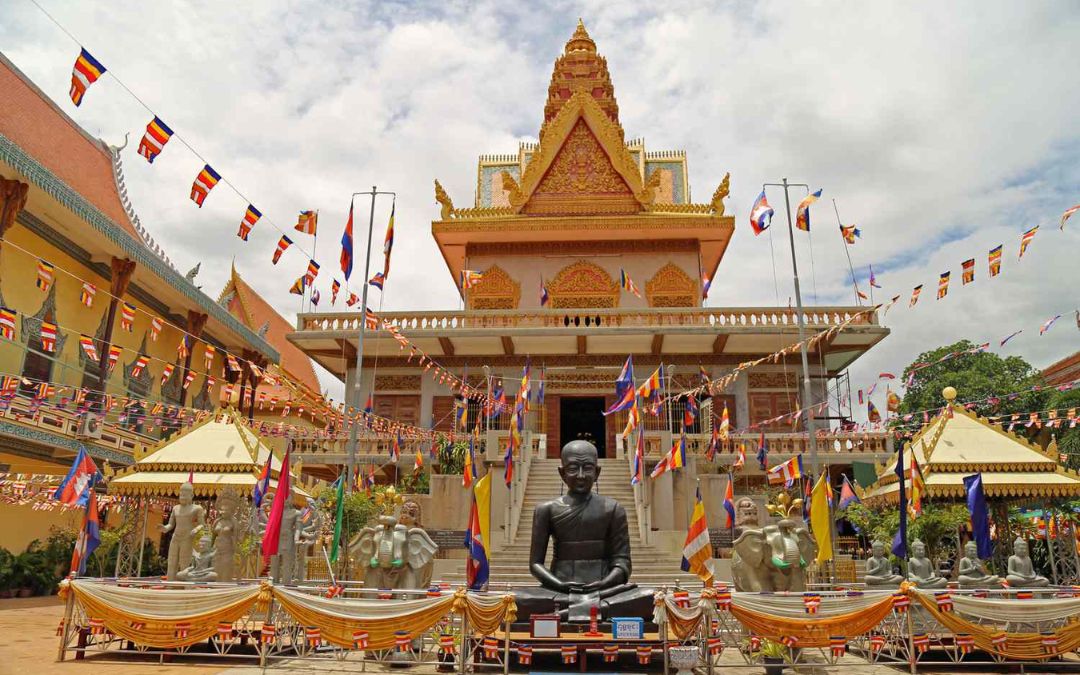
During sacred festivals, Cambodia’s ceremonial gestures can unite communities in spiritual celebration.
>> Read More: Best Cambodia Festivals For Travelers To Explore
Homes & Temples
Dress Modestly
In Cambodia, clothing carries meaning beyond comfort—it is a silent expression of respect, especially when stepping into temples or someone’s home. The golden spires of Angkor or the quiet courtyards of a village pagoda are not just places of beauty but of devotion, and attire is one of the simplest ways to honor that spirit.
- Cover shoulders and knees: Tank tops, shorts, or short skirts may feel fine in tourist hubs, but in sacred spaces, they can seem jarring. A light scarf or shawl makes an easy companion, ready to drape over bare shoulders when needed.
- Choose light, modest layers: Long sleeves and trousers in breathable fabrics are both practical for the tropical sun and respectful in traditional settings.
- Keep it simple: Bright or flashy prints aren’t offensive, yet they can feel out of place amid the stillness of prayer halls. Neat, understated clothing blends harmoniously with the environment’s dignity.
- Note temple rules: At landmarks like Angkor Wat, dress codes are checked at the gates. Even with a ticket in hand, access may be denied if attire isn’t appropriate.
Remove Shoes Before Entry
The act of slipping off your shoes is small, yet it speaks volumes in Cambodia. It is a gesture that honors both cleanliness and the sanctity of the space—whether stepping into a sacred shrine, a humble home, or even a modest shop in a quiet town.
- Homes: Leaving footwear at the doorway keeps the floor pure and is a sign of esteem for the household. Guests may be offered indoor sandals, but often bare feet are welcome.
- Temples: Shoes are never worn on sacred ground. Before approaching shrines or statues, pause to remove them. Socks are acceptable, though many go barefoot as a mark of devotion.
- Shops and offices: In smaller communities, signs or the sight of shoes lined outside hint at the custom. When unsure, follow the lead of locals.
- Mind the placement: Neatly aligning your shoes or carrying them to the side is considered more thoughtful than leaving them scattered.
Keep Your Head Lower
In Cambodian belief, the head is the most sacred part of the body, and posture often reveals one’s awareness of this. Lowering yourself physically is a graceful way of showing humility in Cambodia.
- In homes: When elders are seated on the floor, walking past them with your head lowered shows deference. Sitting at a lower level than the eldest in the room is a simple but powerful act of respect.
- In temples: Keeping your head below that of monks or Buddha statues conveys reverence. During rituals, kneeling or sitting helps you join the rhythm of those around you without overshadowing the moment.
- When taking photos: A subtle bend at the knees or lowering your stance avoids the impression of towering over monks or elders. This small adjustment communicates thoughtfulness more clearly than words.
Must-Visit Etiquette Spot: Angkor Wat Sunrise
There are few sights in the world as breathtaking as dawn at Angkor Wat. The first light spills across the lotus ponds, shadows retreat from the towers, and the temple seems to awaken with the day. It is also a setting where etiquette deepens the experience.
- Dress with reverence: In the cool morning air, shawls and long sleeves bring comfort while ensuring shoulders and knees are covered—so you won’t be turned away at the gates.
- Step inside respectfully: Before entering sanctuaries or climbing temple towers, remove your shoes and set them neatly aside.
- Lower your posture: While the crowds lean forward with cameras, pausing to kneel or sit quietly allows you to feel the hush of dawn prayers around you. The moment becomes more than a photograph—it becomes communion with a place alive in light and spirit.
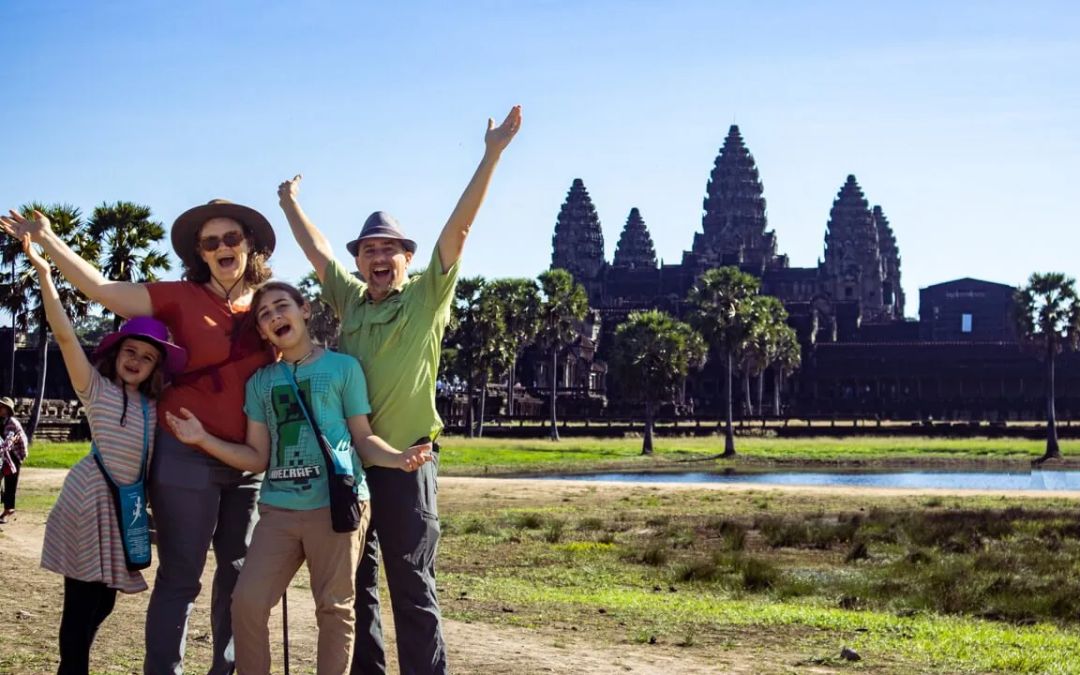
Respectful temple visits demonstrate how Cambodia etiquette transforms tourist experiences into meaningful cultural connections at sacred sites.
>> Read More: Angkor Complex – Travel Guide To Explore The Most Majestic Site of Cambodia
Dining Etiquette
Wait for the Host to Start
Meals in Cambodia are communal experiences, and the sequence of who begins eating is not arbitrary. It reflects a deep respect for hierarchy and the host’s role.
- The eldest or the host begins first. Waiting for them to pick up their spoon or take the first bite is a gesture that acknowledges their role and wisdom.
- Patience sets the tone. Rushing ahead, even unintentionally, can appear careless. That small pause, however, creates an atmosphere of attentiveness and gratitude.
- Let the host guide the flow. Dishes are typically offered rather than taken. Waiting to be served reflects appreciation for the hospitality extended.
- In ceremonies and formal gatherings, the silence before the first bite carries even more meaning—it is a sign of unity, as everyone begins together after the respected figure has started.
Use Right Hand or Both Hands
In Cambodian dining, the way food is passed and received is as telling as the flavors themselves. It is about presence, attentiveness, and a touch of grace.
- Right hand or both hands together. Passing dishes with the right hand or with both hands shows courtesy. Using only the left is avoided in Cambodia etiquette, as it is considered less clean.
- Receiving from elders. When an elder offers you food or tea, take it with both hands. The gesture says, “I am paying attention, I honor this moment”.
- Serve others before yourself. Pouring tea or ladling soup for those around you, especially elders, is a quiet act of thoughtfulness.
- Even in casual meals, these small courtesies are noticed. They remind everyone that dining is not just eating—it is an exchange of respect and generosity.
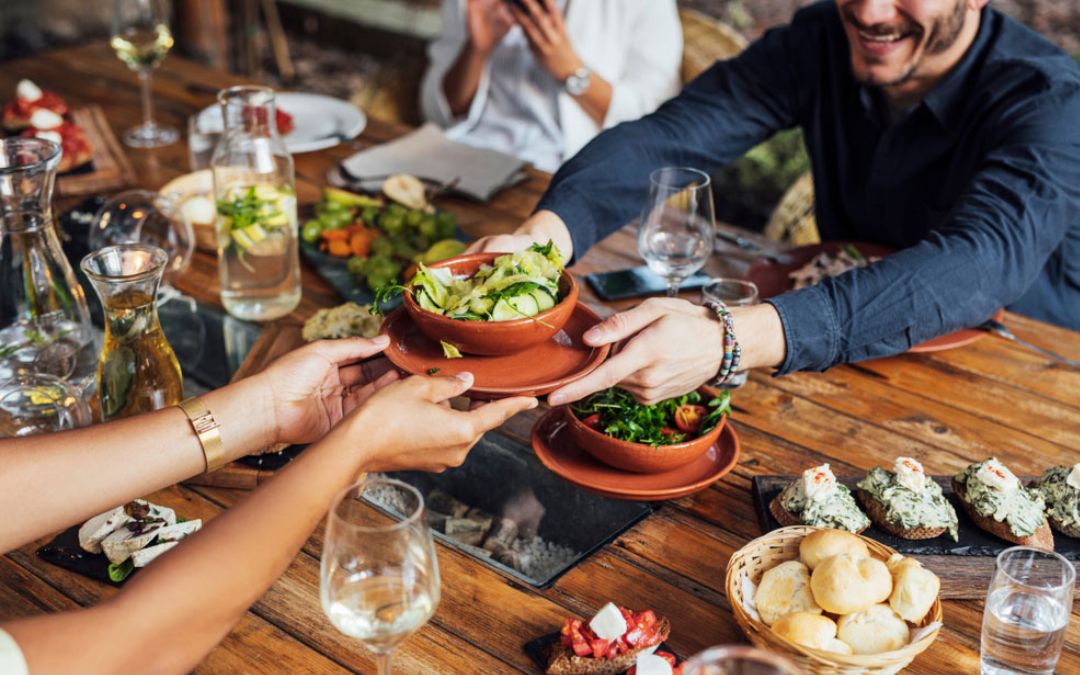
Sharing meals with both hands demonstrates the communal spirit that defines Cambodia etiquette at the dining table.
Mind Table Manners
The Cambodian table is a place of calm connection, where unspoken codes preserve harmony.
- Keep the table clean in spirit. Blowing your nose while eating is frowned upon; if needed, it is best to excuse yourself quietly.
- Discretion with toothpicks. Using one is fine, but cover your mouth with your hand. Modesty is key.
- Sharing is central. Meals are communal, so begin with small portions. Taking too much may seem greedy, while refusing food can be interpreted as dismissing the host’s effort.
- Leave a little behind. An empty plate may suggest the host did not provide enough, while a small remainder signals you are full and grateful.
- Conversations are soft. Voices stay low, interruptions are rare. In many households, mealtime feels like a thread tying generations together, with respect woven into each exchange.
Foodie Tip: Amok Curry with Locals
To taste amok trey, Cambodia’s beloved steamed fish curry wrapped in banana leaves, is to taste the country’s soul. Fragrant with coconut milk and lemongrass, the dish is often prepared for gatherings and shared from the center of the table.
- Amok is a communal dish. The first portion might go to an elder, a monk if present, or even the honored guest—an act that blends hospitality with hierarchy.
- Meals unfold gently. Between spoonfuls, conversation is calm, often interspersed with moments of silence that feel as nourishing as the food itself.
- Guests are encouraged, not pressed. Locals may urge you to try more, but modest acceptance—just enough to show enjoyment without excess—is seen as most respectful.

Traditional dishes like amok curry showcase how Cambodia etiquette encompasses both culinary appreciation and proper dining customs.
>> Read More: Exploring the Best of Street Food in Phnom Penh
Interaction with Monks & Elders
Do Not Touch Monks
In Cambodia, monks are not only spiritual figures but living reminders of a path devoted to simplicity and detachment. Interactions with them are guided by quiet traditions that preserve their sacred role.
- Women cannot touch monks or hand objects directly to them. If something needs to be given, it should be placed on the ground or handed through a man.
- Men are also expected to avoid unnecessary contact. While it is less strict for men, casual touching is considered disrespectful.
- This practice stems from Buddhist rules of conduct. Monks take vows of celibacy and detachment, so physical contact is believed to distract them from their spiritual path.
- Even sitting too close can be inappropriate. Always leave some space when interacting with a monk, whether in temples, buses, or public places.
Show Deference
Reverence for monks runs deep in Cambodia etiquette, shaping gestures, speech, and even body language. To locals, showing respect is second nature—an expression of humility and gratitude toward spiritual teachers.
- A common gesture is the nop (placing palms together at chest or forehead level). This is used when greeting or showing respect.
- Keep your head lower than a monk’s. In temples or homes, this small act symbolizes humility and respect.
- Do not interrupt or talk loudly in their presence. Monks are regarded as spiritual teachers, so quiet and polite behavior is expected.
- Offer seats, especially in public transport. Monks are usually given priority seating, and it is courteous to stand if no other seat is available.
Respect Seating Hierarchy
In Cambodia, even where you sit speaks volumes. Seating arrangements, especially when monks or elders are present, mirror the social and spiritual order.
- Monks usually sit in elevated positions. Whether in temples, ceremonies, or gatherings, they occupy the highest or most respected places.
- Women should never sit directly next to monks. It is considered improper and may cause discomfort.
- In buses or boats, monks often sit at the front or in designated seats. Passengers are expected to adjust accordingly.
- Even outside of religious contexts, hierarchy matters regarding Cambodia etiquette. Elders and monks take precedence in receiving the best or most comfortable seating.
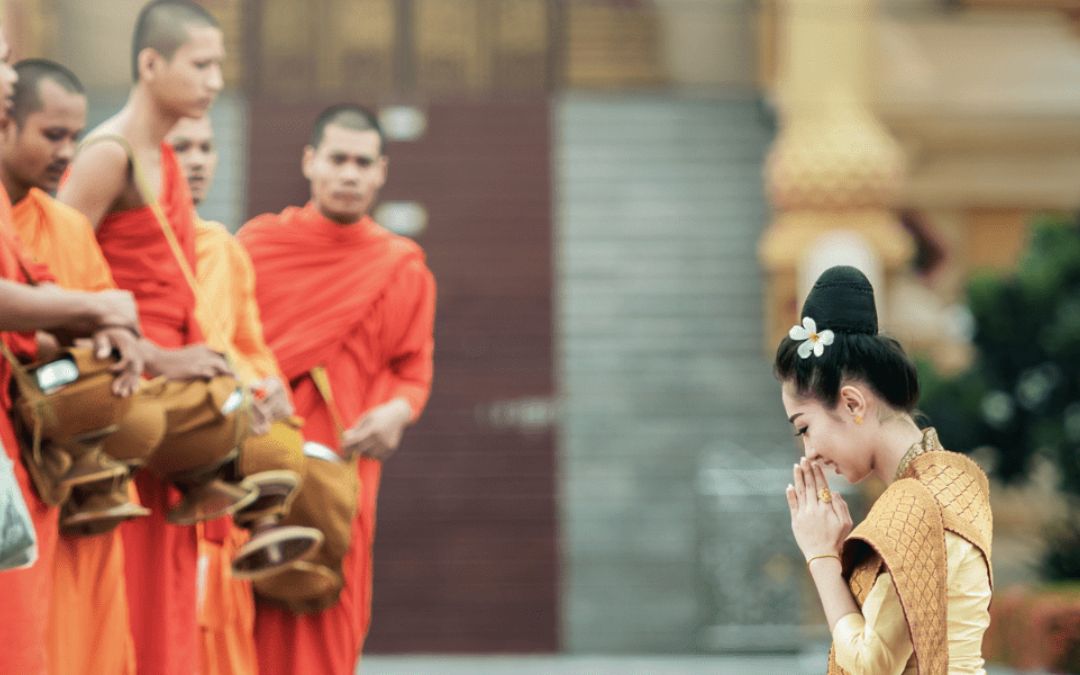
Proper reverence toward Buddhist monks reflects the deeply spiritual foundation of Cambodia etiquette and cultural respect.
Experience Tip: Morning Alms Ceremony
One of the most moving sights in Cambodia unfolds in the quiet blue of dawn: the Tak Bat, or morning alms ceremony. The air is hushed, broken only by the soft shuffle of bare feet on the pavement.
- The ceremony takes place at dawn. Monks walk silently through the streets while laypeople offer sticky rice, fruit, or snacks.
- Travelers may join, but only if they observe local etiquette. Women should kneel or sit lower than the monks, while men may stand or kneel respectfully.
- Do not use flash photography or stand too close. The ceremony is spiritual, not a tourist performance.
- Prepare offerings in advance. Rice and food should be clean, modest, and respectfully presented.
- Silence is important. Locals treat the ritual as a form of meditation, so participants should behave calmly and quietly.
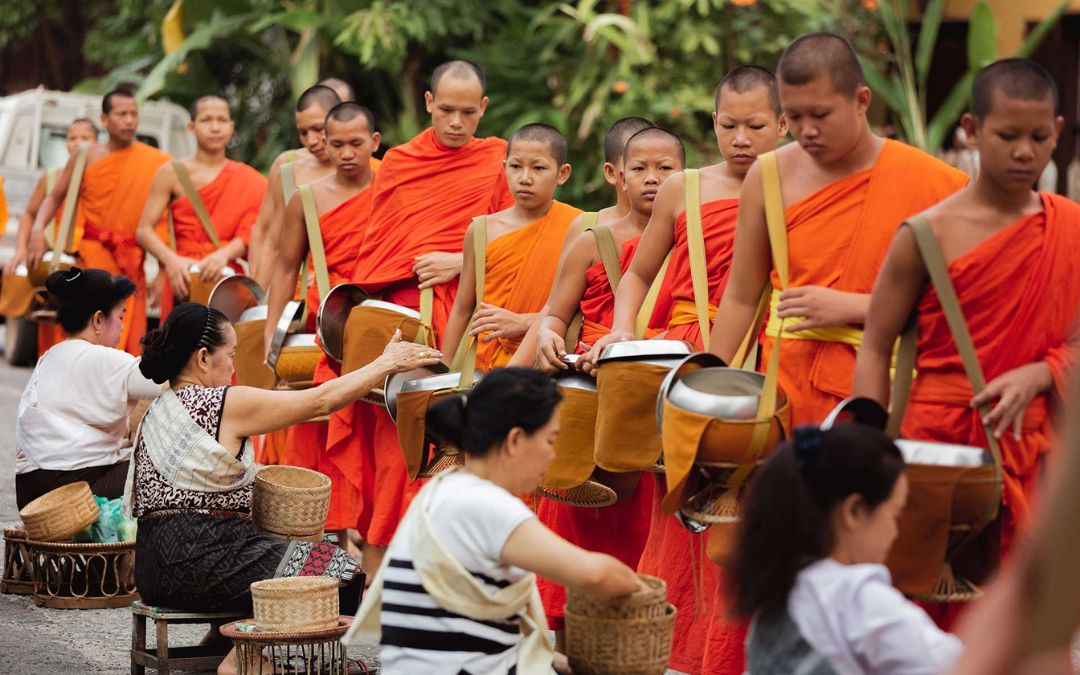
Almsgiving ceremonies like Tak Bat honor Buddhist traditions through respectful participation and generous offerings.
Public Behavior
Stay Calm & Soft-Spoken
In Cambodia, speaking in a soft and measured tone is more than politeness—it reflects self-control and respect for those around you.
Raising your voice or showing aggression is considered disruptive, breaking the harmony that locals value in daily interactions.
Even when frustrations arise—whether at a crowded market stall or while negotiating the price of a tuk-tuk ride—Laotians tend to remain composed. Losing your temper doesn’t just affect you; it may cause embarrassment for both you and the person you’re speaking with.
If a misunderstanding occurs, the best approach is to keep your voice low and your words kind. Very often, this calm energy defuses tension, allowing both sides to resolve the issue quickly and with dignity intact.
Avoid PDA (Public Displays of Affection)
Modesty is woven into the fabric of Lao culture, and intimacy is regarded as something deeply private.
Holding hands is usually acceptable in public, especially in larger cities, but overt gestures—like kissing, hugging, or lingering embraces—are frowned upon. Such displays can feel out of place in a society that values discretion.
Even married couples rarely show affection openly, since public romance is seen as disrespectful and potentially uncomfortable for onlookers.
For travelers, this is especially important in smaller towns and rural villages, where traditional values hold strongest. Keeping affection private not only shows respect but also allows you to blend more naturally into Cambodia etiquette norms.
Mind Your Feet
In Buddhist cultures across Southeast Asia, feet are considered the lowest and most unclean part of the body, and Cambodia is no exception. How you position or use them carries symbolic weight.
- Pointing your feet directly at people, monks, or Buddha images is seen as disrespectful, almost like pointing an insult without words.
- It is also impolite to step over someone seated on the ground. Instead, pause or carefully walk around, acknowledging their presence.
- When sitting, tucking your feet beneath you—or folding them to one side—shows attentiveness. Stretching them out casually, especially toward sacred objects, is considered careless.
- In temples, posture matters even more. Sitting with your feet pointed toward the altar or Buddha statues is highly disrespectful, so travelers often kneel or sit cross-legged instead, mirroring the quiet reverence of the locals.
Where This Applies: Markets, Buses, Public Gatherings
These guidelines aren’t just for temples or formal settings — they apply everywhere in daily life.
- In the bustle of a morning market, where baskets overflow with herbs and spices, patience and a calm demeanor carry you further than haste or raised voices.
- On buses or shared songthaews, keeping your tone soft and your body language respectful ensures that the journey is pleasant not only for you but also for fellow passengers who may be traveling long distances.
- During festivals or public ceremonies—moments filled with music, chanting, and celebration—observing these social norms allows you to take part without unintentionally offending those who are honoring traditions.
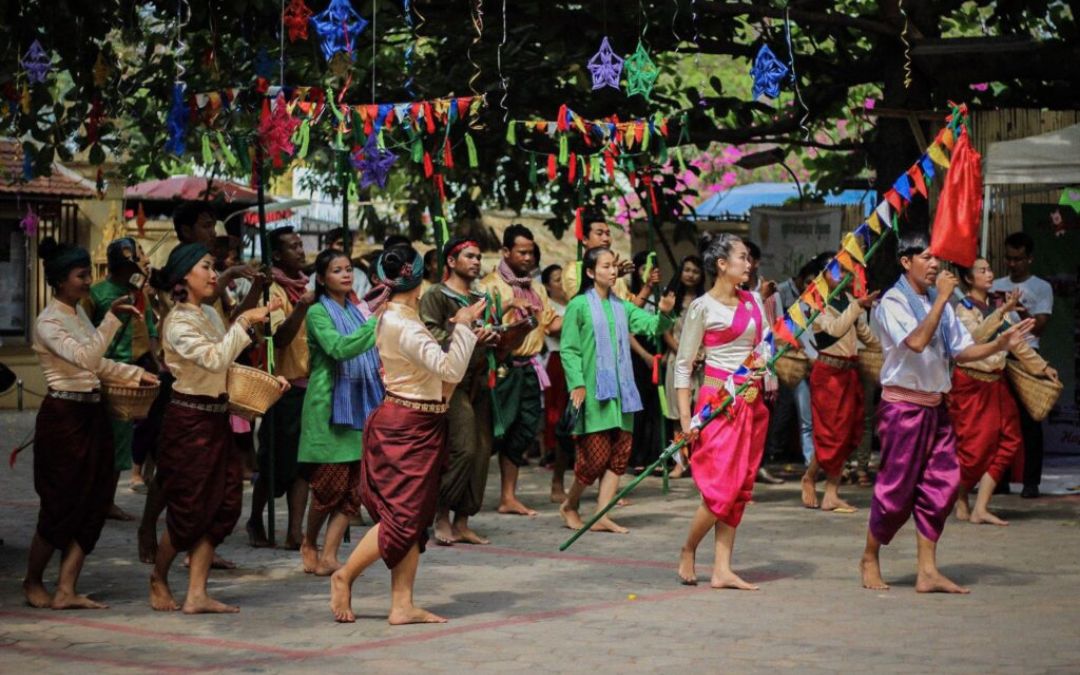
Community celebrations reveal how Cambodia etiquette extends beyond formal settings.
>> Read More: How To Plan An Amazing Cambodia Family Holiday
Final Words
While traveling to Cambodia, a deeply Buddhist country, etiquette matters more than you might expect. It is not only about rules, but also about respect, harmony, and the gentle rhythm of everyday life. With this detailed guide, you will feel confident moving through Cambodia’s daily life. By practicing Cambodia etiquette, you don’t just avoid mistakes; you open doors to warmer interactions, genuine hospitality, and a deeper sense of belonging during your journey.
If your heart is drawn to Cambodia’s timeless beauty and quiet wisdom, Asia Pioneer Travel is here to design an itinerary that goes beyond the sights—helping you connect with the country most authentically and respectfully. Contact now!



